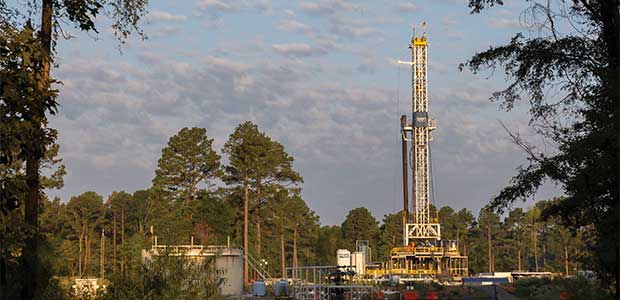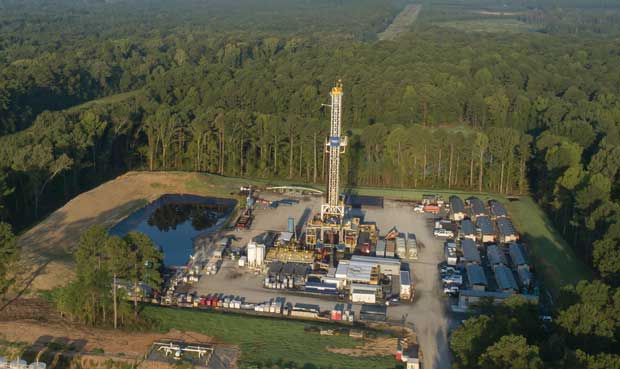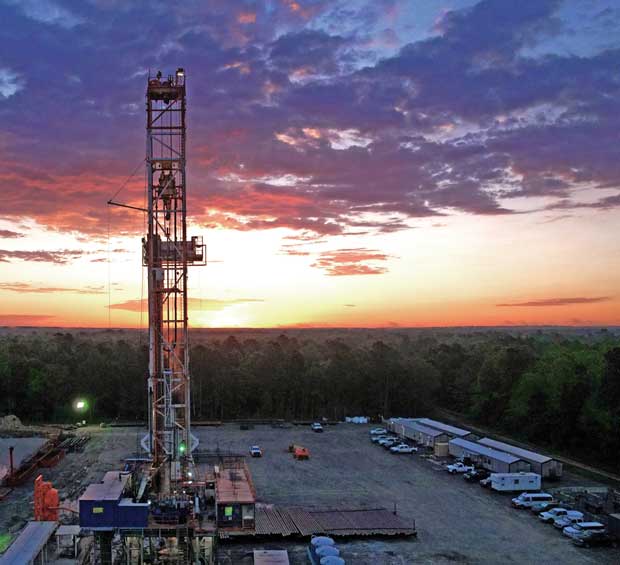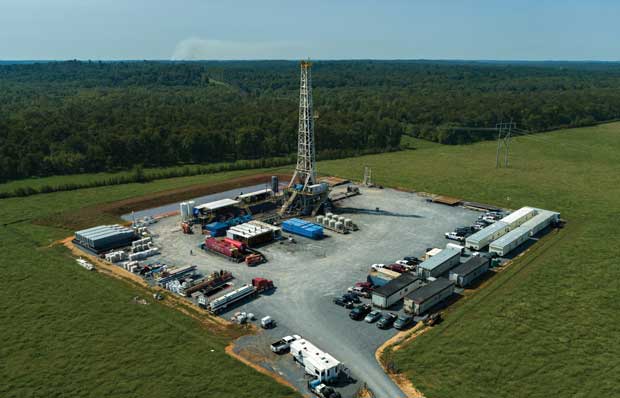
Haynesville Operators Answering Demand Call For Clean, Reliable Natural Gas
By Al Pickett, Special Correspondent
HOUSTON–Outside of a relative handful of independents–many of them small private players–the Haynesville Shale and its massive cache of natural gas remained largely in the shadows of liquids-rich shale basins during the past decade. But no more. The comeback is on!
A new day has dawned across northwestern Louisiana and northeastern Texas. Natural gas is again in high demand, and the Haynesville has at least 300 trillion cubic feet in reserve, according to the U.S. Geological Survey’s
assessment. Suddenly, the play that once was off the beaten path is a hopping hot spot once again, particularly as the global call for U.S. natural gas intensifies.
Buoyed by strong demand, an ideal geographic location in strategic proximity to Gulf Coast petrochemical and liquified natural gas export hubs, increasingly sophisticated drilling and development techniques, and of course, the healthiest sustained natural gas prices in years, the Haynesville’s tactical position in the long-term supply chain has never looked more secure nor its future any brighter.
According to Clay Carrell, executive vice president and chief operating officer of Spring, Tx.-based Southwestern Energy Co., his own company’s story is emblematic of the tale of the Haynesville itself since it was “discovered” in 2008.
“We had a small position in the Haynesville Shale on the Texas side that we divested in the 2010-11 time frame,” explains Carrell. “When gas prices fell, the industry shifted its focus to the oil shales and mostly private companies remained active in the Haynesville. More recently, with a focus on consolidation, and given the increased expected natural gas demand from liquefied natural gas, there are more public companies in the basin, using improved completion technology they perfected in other plays, such as the Marcellus/Utica in Appalachia, Eagle Ford in South Texas and the Wolfcamp in the Permian Basin. We continue to see improvement in the second phase of drilling in the Haynesville.”
Major Acquisitions
Southwestern Energy is the largest producer in the Haynesville and one of the largest in the United States, thanks to two major acquisitions in 2021. First, Southwestern Energy purchased Indigo Natural Resources for $2.7 billion. Then in December, it acquired GEP Haynesville, a deal that added about 700 million cubic feet of daily Haynesville production to the company’s total gas volumes, right as wellhead prices began to churn upward toward their highest seasonal levels since-serendipitously enough-2008 when the first commercial well was drilled and completed in the play.
Carrell says Southwestern Energy was the first public company to consolidate a large-scale private operator as the Haynesville began to generate renewed interest. The company identified the Indigo position as the “highest-quality wells,” he notes, and the GEP acquisition was a “complementary addition to give us a contiguous acreage position.”
Southwestern Energy has returned to the Haynesville in a big way. In order to capture the tangible benefits of scale, Southwestern closed on two major Haynesville acquisitions last year that position it as one of the largest producers in both dominant U.S. natural gas shale plays: the Haynesville and the Marcellus/Utica.
“We now have 257,000 net acres in the Haynesville,” Carrell points out. “We have 700 producing wells with approximately 1.9 billion cubic feet a day net production. We currently have seven rigs running, although our full-year program is expected to average eight-nine rigs. We plan to drill 60-65 wells, complete 65-70 wells and turn 70-75 wells to sales in 2022.”
Additionally, Carrell points out that the company also has more than 1,700 economic future drilling locations identified across its leasehold, concentrated in a core position in southeastern DeSoto Parish, along with Red River, Sabine and Natchitoches parishes.
“The majority of our acreage is stacked pays with both the Haynesville and Middle Bossier targets,” Carrell continues. “Many companies do not have that advantage. It is really an extension of the original core play, moving to the southeast. It is deeper with higher pressure, and it makes some of the best wells.”
Southwestern Energy is drilling two or three wells per pad, completing in both the Haynesville and Middle Bossier, which lies above the Haynesville. This year, 60% of Southwestern’s wells will be drilled in the Haynesville and 40% in the Middle Bossier.
These are deep wells, averaging 11,000-13,000 feet across the acreage and more than 13,000 feet in the Natchitoches Fault zone. Well costs average $1,700 per completed lateral foot, split 50-50 between completion and drilling, according to Carrell.
“These wells have the highest pressure and higher cost, but they are some of the best performing wells in the play,” he emphasizes. “We are delivering 2.5 billion cubic feet of estimated ultimate recovery per 1,000 lateral feet with returns in excess of 100% and payouts within one year. Unlocking the productivity is part of the attractiveness of the Haynesville for us. The economics are stellar, with the very strong production profiles and EURs.”
Dual Basin Operator
Carrell claims Southwestern Energy is unique in that it is a “dual basin natural gas operator” as one of the leading producers in the nation’s two premier natural gas shale plays: the Haynesville and Marcellus/Utica. They are different, however.
In Appalachia, Southwestern Energy is not only focusing on dry gas inventory in Pennsylvania and Ohio, but also rich and super-rich opportunities in West Virginia and Ohio. “Natural gas liquids and condensate are a major factor in Appalachia,” he states. “Our production in Appalachia is about 80% gas and 20% liquids, while our position in the Haynesville is all dry gas.”
Much like it did in the Marcellus and Utica wells in Appalachia, Southwestern Energy is slowly increasing lateral lengths in the Haynesville, according to Carrell.
“The previous operator was drilling 8,000-foot laterals,” he reflects. “Now we are averaging over 9,000 feet. That is in line with the way we advanced in Appalachia. We went from 7,500 feet to eventually 15,000 feet in average lateral lengths. Faulting, higher pressure and temperatures in the Haynesville mean we may not average the same lateral lengths as in Appalachia, but we expect to extend the program longer.”
Carrell adds that the company also is applying lessons learned in Appalachia in well spacing, stage cluster spacing, completion techniques and improving spud-to-release times.
“Operational efficiency will lower costs and optimize the best wells,” he claims. “We lowered our well costs 45% in Appalachia between 2018 and 2021. We have brought two of our own Southwestern-owned rigs to the Haynesville and are sharing our knowledge with our third-party rigs. We are also using data analytics to customize completions designs.”
He says initial production rates have increased from an average 26 MMcf/d nearly 35 MMcf/d with a range from 25 MMcf/d to a high of 50 MMcf/d.
Market Connections
One of the attractive features of the Haynesville Shale, of course, is its nearby access to the LNG and petrochemical demand centers along the Texas and Louisiana coastlines. As activity has picked up in the Hayneville, Carrell acknowledges that some operators are losing interruptible space if they do not have firm transportation. That is not a problem for Southwestern Energy, however.
“Before we made our acquisitions, we needed to know that we could get our production to sales,” Carrell points out. “We have firm capacity today, and with the steps we have taken, we have added 300 MMcf/d of incremental capacity coming on line by year-end 2024, which ensures we can move increased production.”
He says the new Gulf Run Pipeline, which is scheduled to come on line soon, will add 1.6 Bcf/d of capacity for Haynesville production. Other pipelines are expected to be added in the next several years, reflecting the favorable operating and regulatory environment in Louisiana.
U.S. natural gas demand is expected to increase by more than 10 Bcf/d by 2025, with the largest increases from LNG, Mexico pipeline exports and the domestic industrial sector. Of course, sanctions on Russian supplies also factor considerably into future demand calculations, as U.S. producers are asked to export more LNG to Europe and Asia. There are a dozen LNG terminals either in operation or in various stages of development along the Gulf Coast.
“We are one of the largest suppliers to existing LNG terminals, selling 1.5 Bcf/d of our production to those facilities today, and in total can get 3.0 Bcf/d to Gulf Coast markets. With our strategically located assets and market access, we have the opportunity to participate in the next wave of LNG exports,” Carrell relates.
He says the industry is “seeing an improved commodity price cycle” now, although inflation has offset some of that. The company has a number of gas hedges in place, according to Carrell, which helps protect the balance sheet. The current natural gas prices have accelerated free cash flow for the company, as noted by Bill Way, Southwestern Energy’s president and chief executive officer, during the company’s second-quarter earnings report.
“During the second quarter, Southwestern Energy continued to execute on our plan while complementing our debt repayment priority with a share repurchase program,” Way stated. “We believe this program will narrow the disconnect between our enterprise value and our inherent asset value, as reflected in our second quarter PV-10 reserve value of $31 billion at recent strip prices. The program also underscores the free cash flow generation capability of our dual-basin assets and firm transportation portfolio providing market optionality, including being one of the nation’s largest suppliers of natural gas to LNG.”
Carrell predicts that natural gas will prove foundational to a lower-carbon future because of a growing understanding in the nation and around the world of the critical importance of natural gas in any transition toward lower-carbon energy resources.
“We will play a key role in all of that,” he claims. “We are perfectly positioned. We were early movers in ESG, which is a core value of the company. We continuously monitor the emissions of our operations, certify our production as responsibly sourced gas and strive to be a company that does things right.”
Positive Numbers
The numbers in the Haynesville bear out the impact of strong natural gas prices, according to Comstock Resources Chairman and Chief Executive Officer Jay Allison.
“Since mid-2021, the natural gas rig count in the Haynesville shale has increased to approximately 70 rigs currently, up from about 50 rigs 12 months ago,” Allison points out. “Over the same time frame, the number of completion crews working in the Haynesville shale has increased to almost 30 frac spreads, up from fewer than 20 spreads about 12 months ago.”
Comstock Resources is optimizing lateral lengths on Haynesville and Bossier wells across its 372,000 net acres in North Louisiana and East Texas. The company expects average lateral lengths on its wells to increase from 8,800 feet in 2021 to almost 10,000 feet this year. To date, Comstock has drilled 11 wells with 15,000-foot laterals.
And those are not the only numbers trending in a positive direction. Obviously, the strong natural gas prices are driving significantly increased cash flow generation for companies such as Comstock Resources, which is one of the largest operators in the Haynesville play.
“As of the beginning of 2022, Comstock held 372,000 net acres in North Louisiana and East Texas prospective for both the Haynesville Shale and Bossier Shale,” Allison says. “Comstock recently added two rigs and is currently operating nine rigs. In 2022, we plan to drill 75-80 gross wells and turn 55 net wells to sales.”
In Louisiana, Comstock operates in DeSoto, Red River, Bossier, Webster, Bienville, Caddo and Sabine parishes. On the Texas side, it operates primarily in Harrison and Panola counties with delineation activity of exploratory Haynesville/Bossier potential currently underway in Robertson County.
Allison maintains that while his company continues to look to make improvements on each well drilled, the well design within the core of the Haynesville in North Louisiana and East Texas is pretty well established.
“The one area where we continue to look to improve is drilling longer laterals, which drives improved well economics,” he continues. “In 2022, we expect our average lateral length to increase 13%-14% to almost 10,000 feet, up from 8,800 feet in 2021. Looking ahead to 2023 and beyond, we will continue to look to further expand our lateral lengths as the number of wells with laterals up to 15,000 feet in length increases. To date, we have drilled a total of 11 wells with lateral lengths of approximately 15,000 feet, and results to date suggest similar estimated ultimate recoveries per 1,000 foot of lateral.”
It is also optimizing around preferred well spacing and frac designs, he adds. “Since the latter part of 2020, we have been using about 3,500 pounds of sand and 80-90 barrels of fluid per lateral foot in our typical well,” Allison relates. “In terms of spacing, we continue to target five wells per bench in each of the Haynesville and Bossier across a majority of our acreage.”
Ample Capacity
Allison says Haynesville pipeline capacity is running at an estimated 90%-95%.
“While Comstock has lined up access to ample takeaway capacity to meet our increased production targets, the basin as a whole is getting tighter on both long-haul pipelines and gathering systems,” he observes. “Smaller operators and those without longer-term pipeline agreements could face some constraints. Growing U.S. LNG export capacity has increased the demand for natural gas. Since 2016, LNG exports have increased from only 0.6 Bcf/d to a peak of almost 14 Bcf/d earlier this year before the Freeport LNG facility was shut down for repairs.”
About 2 Bcf/d of LNG exports remain off line until an anticipated Freeport restart date in mid-November, according to Allison.
“We currently sell approximately 15% of our production directly to LNG shippers,” he goes on. “Given pipeline arrangements we have in place, we sell roughly 70% of our natural gas in the high-value Gulf Coast markets, and we continue to evaluate opportunities to further increase that figure.”
Allison claims the Haynesville Shale’s location some 200 miles from the Gulf Coast provides the basin with a significant cost advantage compared with natural gas supplies from Appalachia and the Mid-Continent.
“With an additional 7 Bcf/d-10 Bcf/d of LNG export capacity expected to come on line along the Gulf Coast within the next five years, the call on Gulf Coast natural gas should continue to grow,” he remarks. “With more than 1,600 drilling locations (a 25-year inventory at current activity levels) on our core Haynesville position, Comstock is one of the few companies with the high-quality inventory depth to supply to the LNG terminals to allow them to meet the long-term contracts they are entering into with European counterparts.”
Unique Business Model
Tellurian Production LLC, which has been actively drilling in the Haynesville since 2017, has developed a unique business model to meet the growing LNG export demand. The Houston-based company is currently building the Driftwood LNG terminal south of Lake Charles, La., as well as the 96-mile Driftwood Pipeline and proposed dual laterals.
It is anticipated to be about four years before the Driftwood facility comes fully on line, but when it does, Tellurian will own and operate upstream assets, a pipeline network and an LNG terminal, giving the company the ability to sell its natural gas into domestic or international markets using entirely its own wells, pipeline and LNG asset to produce, transport and liquefy supplies.
When Tellurian completes construction of its Driftwood LNG terminal south of Lake Charles, La., and the 96-mile Driftwood Pipeline, it will have the unique ability to produce, transport and liquefy Haynesville natural gas for delivery to international markets. The Driftwood LNG terminal will have a planned maximum capacity of 4 Bcf/d.
“I don’t believe there is another company like us in the United States,” Tellurian Production President John Howie says. “It is very applicable to the environment we are in today.”
When operational, the Driftwood LNG terminal will handle what Howie describes as a “robust and diverse supply” with a capacity of 4 Bcf/d, meaning the facility will handle third-party supplies as well as its own natural gas produced by Tellurian.
In the meantime, Howie says Tellurian is “producing gas that we sell on the open market and growing our position.”
Howie was part of an eight-member team with vast experience in the oil and gas industry that joined Tellurian in 2017. “We made our first acquisition in the Haynesville in 2017,” he states. “The original acreage had 20 producing wells and more than 10,000 acres.”
Then in August, Tellurian announced the acquisition of certain assets in the Haynesville from privately held EnSight IV Energy Partners LLC and EnSight Haynesville Partners LLC, giving the company another 20 producing wells and an additional 5,000 acres. All told, Tellurian has drilled 20 wells and now has more than 20,000 acres in DeSoto, Bossier, Red River, Webster and Natchitoches parishes with an inventory of more than 275 high return, de-risked drilling locations, according to Howie.
He says Tellurian had three rigs operating earlier this year, but currently is running two rigs. Howie contends the entire industry has gotten much more efficient in frac designs with tighter spacing and pumping more fluid and sand.
“The Haynesville is very large so it varies, but we are pumping 3,500-4,000 pounds per lateral foot on our acreage,” he offers.
Even though Haynesville wells are deeper and higher pressured, Howie calls the Haynesville an “established, reasonably mature, highly prolific and low-cost basin” with well understood geologic and operational variables. “I think we will continue to see advances in natural gas,” he adds.
Howie says Tellurian pays close attention to its ESG performance right alongside its economic and operational metrics.
“We are fortunate that we do not have any liquids associated with our wells in the Haynesville,” he points out. “We produce natural gas and a little saltwater, so it is a very clean operation. But we continuously monitor for methane leaks. We measure and quantify. We take operating as cleanly and responsibly as possible very seriously.
For other great articles about exploration, drilling, completions and production, subscribe to The American Oil & Gas Reporter and bookmark www.aogr.com.









